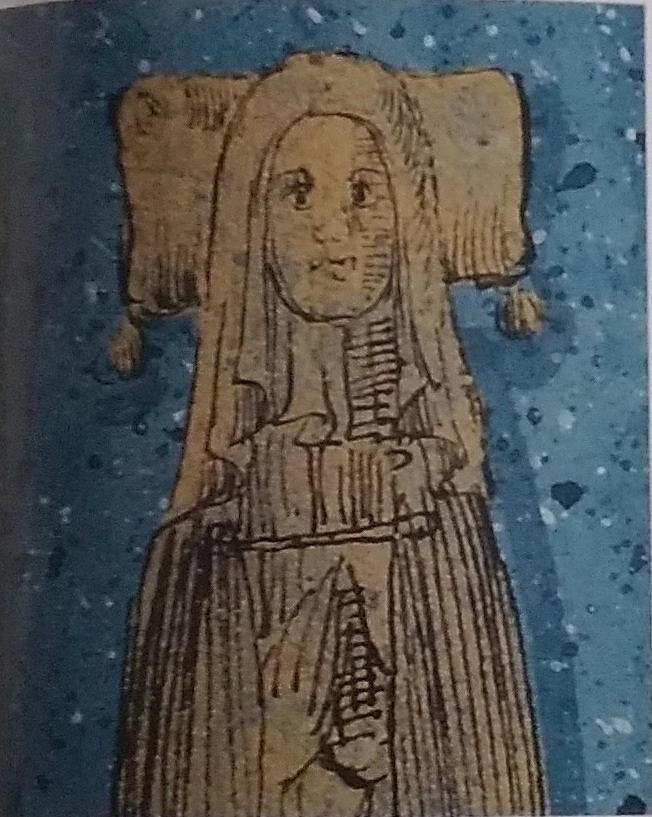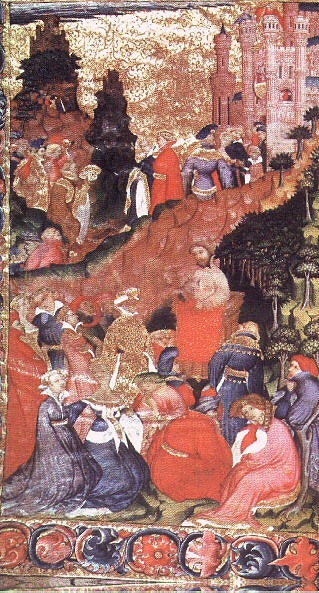KatherineSwynford

Unknown Artist: Katherine Swynford,
from her tomb, Lincoln Cathedral (1403)
"Swynford was an exceptional presence."
My eighteenth great-grandmother was born Katherine de Roet in 1349, in Hainaut, a territorial lordship straddling the current border of France and Belgium, the daughter of a knight. She came to England as a child when her father accompanied Phillippa, a daughter of William of Holland, when she married King Edward III. She was raised in the English royal household and reportedly started working there when she was ten, tending to the royal children. One of the king's sons, John of Gaunt, nine years Katherine's senior, knew her well. Katherine married Hugh Swynford, one of Gaunt's knights, at thirteen, a common enough age for noblewomen to marry then. Swynford owned a fiefdom but a poor one. Katherine dedicated herself to caring for the estate, Kettlethorpe, after Swynford died in Aquitaine in 1771 while on a military expedition with Gaunt, leaving her with four children.
Katherine was in and out of the King's and Gaunt's employ after that. She worked as a handmaid and caring for children and lived as a member of both Gaunt's and his father, the king's families. History does not record when she became Gaunt's mistress. By 1373, she gave birth to the first of four initially illegitimate children with Gaunt, while she was charged with caring for Gaunt's legitimate children from his first marriage. Gaunt married a second time in 1371 to Constance of Castile and hired Katherine into his new wife's household. She was present in 1372 when Gaunt and Constance's daughter Catherine, who would later marry Henry II's grandson, Henry III, was born. Constance would live for another twenty years without further issue. Gaunt attempted to recapture the throne of Spain for her but failed in a spectacular display of inept leadership.
Katherine's affair with Gaunt was an open secret, perfectly respectable as long as it was not publicly acknowledged. Gaunt's fellow nobles disapproved of his choice of a commoner for a mistress, though Katherine was reportedly beautiful and of noble bearing. How could she not have been after spending so many years as a member of the royal entourage? "In 1373, the Castilian ladies of his wife knew that the Duke had a mistress, as a result of which, angry because of their gossip, John of Gaunt sent them to Nuneaton Priory. By the end of 1374, the ladies, weary of the monastic regime, begged to leave Nuneaton; their request was only granted in 1375 when the Duke allowed them to settle in Leicester with some of his trusted vassals. He later arranged marriages for some of the ladies. Duchess Constance (Gaunt's wife) also knew about her husband's affair, but for her, the return of the Castilian throne was much more important." [Wikipedia]
In 1378, Gaunt made the mistake of parading in public with Katherine. Great disapproval resulted. After the Peasant's Revolt in 1381, where Gaunt's London palace was trashed and several killed, Gaunt decided to publicly separate from Katherine. Their affair continued clandestinely. When his Dutchess died in 1394, Gaunt could again go public with their affair. By then, they had four illegitimate children. He married Katherine in January 1496 and petitioned the pope to grant the marriage and their offspring legitimacy. This was eventually granted by Pope Boniface IX, who declared the marriage of John of Gaunt and Katherine Swynford valid by a bull. In addition, he legitimized their children born before marriage –the Beauforts, much to the disgust of many of Gaunt's nobility. Through all this turbulence, Katherine held fast, comporting herself like the lady she most certainly was. She accumulated considerable property, some of which she retained after Gaunt's death in 1398. All Hell broke loose on Gaunt's death. Much of his land was seized, though some of it was regranted by Richard II, who was somewhat sympathetic to Katherine's plight.
Their once-illegitimate children married well and prospered, though several grandchildren would be killed during the War of the Roses, which saw the end of Gaunt's extensive holdings. Swynford was an exceptional presence. She became extraordinarily well-connected. Her sister married Geoffrey Chaucer. She is reportedly depicted in a frontispiece manuscript illustration from that period. "One of the seated women, dressed in a flowing blue dress with dangling sleeves (known as houppelande), with a wide collar trimmed with white cloth, and a golden belt, is Katherine Swynford." [Wikipedia]

Geoffrey Chaucer reciting Troylus and Criseyde:
early 15th-century manuscript of the work.
Currently at Corpus Christi College, Cambridge.
©2024 by David A. Schmaltz - all rights reserved


